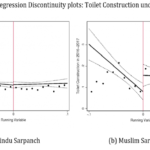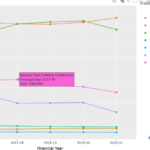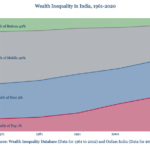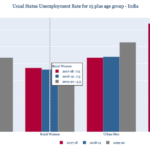Does the wording in a job ad matter for the gender mix of job applicants?
In 2017, only 24% of urban Indian women above the age of 15 were working or looking for work compared to 82% men.[i] Moreover, women who were employed earned 38% lower wages than men on an average.[ii]The extant literature on gender disparities in employment, wages and occupational segregation shows that these disparities can exist due to due to supply-side factors or employer discrimination. These can manifest either during the hiring process or as workers advance through their careers. While the final matching of candidates with jobs plays an important role, these gender disparities can have their genesis in the job search and application behavior of the candidates.
Previous studies for China, Indonesia, and Mexico (Kuhn and Shen 2013; and Kuhn, Shen, and Zhang 2020; Ningrum, Pansombut and Ueranantasun 2020; Helleseter, Kuhn and Shen 2020) have examined discrimination at the hiring stage by studying gender preferences exhibited in online job ads. In India too it is not unusual for employers to express explicit gender preferences in the job ads they post online (Chowdhury et al. (2020)).[iii]
In this article, we describe the findings from our paper which examines such preferences using job ads posted on an online job portal in India that caters primarily to young urban job seekers. Our final data comprises 1,57,890 job ads that specify job location within a single state and for which we can obtain a detailed occupational classification. We also use data on all applications made to these ads (by 1.06 million active job seekers) to study the impact of explicit preferences on search behavior.[iv]
Gender targeting in job ads
The portal does not have a separate field that allows employers to directly state the preferred gender for an advertised job to the job seekers. However, employers can state this in the accompanying job description. We construct variables indicating an employer’s gender preference by carrying out a text search within the job title and description for each job ad.[v] Approximately 4.5% of the job ads in our sample have an explicit female preference, 3.8% have an explicit male preference, and the rest have no explicit gender preference.
Figure 1 shows word clouds of job titles in these three types of job ads in our sample. It can be seen that job titles such as `telecaller’ and `office executive’ occur frequently in female targeted jobs while titles such as `delivery boy’ and `sales executive’ are common among male targeted jobs. These confirm that explicit gender preferences are related to existing occupational gender stereotypes.
We also find that jobs that specify higher education/experience/wage are less likely to exhibit an explicit gender preference, even within the same occupation. This indicates that jobs with lower skill requirements in the Indian labor market are more likely to indicate a gender preference, consistent with the previous evidence from other countries. Within the set of gender-targeted ads, jobs having an explicit male preference are less likely to require higher education but are more likely to require more experience (> 2 years) and advertise higher wages than the jobs that explicitly prefer women.
Gender targeting and female applicant share
Gender segregation at the application stage will occur if candidates comply with the gender requests. We find that the fraction of female applicants to a vacancy increases by around 16 percentage points when the employer indicates an explicit female preference and reduces by 9 percentage points in case of an explicit male preference, even within the same occupation. These translate into an increase of 50% and a decrease of 28% in the share of female applicants to female and male-targeted job ads respectively, which are quite substantial.
Implicit gender associations
Even in the absence of explicit gender request, the text contained in a job ad may send an implicit signal to a candidate regarding whether the employer posting the ad prefers a female or a male candidate for the job. To test this, we calculate how predictive the text in a job ad is of the explicit gender requests using a machine learning (ML) approach.[vi]We find that for job ads that are not explicitly targeted at any gender, an increase in predicted femaleness (increasingly female job description i.e. use of words in the description which reflect job traits more likely to be associated with females) from zero to one (i.e., zero to perfect female association) leads to a reduction in the advertised wages by 29% within the same occupation and location.
We then plot the predicted gender shares of applicants and how they vary with the associated femaleness and maleness within the same occupation(Figure 2). Two striking findings emerge from the figure. One, as “femaleness” associated with a job description increases in the gender non-targeted ads, the female application share increases. Second, even in the presence of an explicit request for women, the proportion of female applicants increase with “femaleness”.
To further delve into the source of such variation, we categorize words in the job text into those related to skills, personality and job flexibility by gender.[vii]For instance, female skills related words include ‘makeup’, ‘Tally’, ‘emailing’, ‘proofreading’ – skills associated with stereotypical female tasks whereas male related skills include knowledge of tools like ‘OOP/Corel/API’, ‘driving/repairing’, ‘negotiation’ and ‘pitching’. Personality and appearance traits like ‘pleasant’ and ‘complexion’ occur when requesting for women candidates while ‘multitask’, ‘determination’, ‘vigilant’ occur when requesting for men. Job flexibility is lower in jobs requesting men – since words like ‘rotational/night/evening shifts’, ‘travel’, ‘relocate’ for work are more common in ads requesting men.
We also find that female skills and male job flexibility related words increase and decrease female applicant shares respectively. Moreover, jobs requiring skills associated with women entail a wage penalty, whereas those associated with men engender a significant wage premium.
Implications
Collectively, these findings indicate that gendered wording of job descriptions matters for female applicant shares and contributes to the gender wage gap in the Indian labor market. We are further able to detect sources of gender disparity by examining which stereotypes matter. Our results have implications for whether banning gender targeting in job ads can be an effective tool for narrowing gender segregation and eliminating the gender pay gap in the labor market. Given that female applicant shares are higher (lower) in gender non-targeted ads (male-targeted ads), restricting employers from stating their gender preference can reduce gender segregation at the application stage. However, it is unlikely to eliminate it as long as stereotypical gender associations exist in the labor market. Achieving greater gender parity in the labor market requires a broader transformation of traditional gender roles that affect applicant behavior and employers’ preferences.
This data story is based on the paper “Words Matter: Gender, Jobs and Applicant Behavior” (co-authored with Sugat Chaturvedi, Indian Statistical Institute and Zahra Siddique, University of Bristol)
References
Chowdhury, A. R., A. C. Areias, S. Imaizumi, S. Nomura, and F. Yamauchi(2018):Reflections of employers’ gender preferences in job ads in India: an analysis of online job portaldata, The World Bank.
Helleseter, M. D., P. Kuhn, and K. Shen(2020): “The Age Twist in Employers’ GenderRequests Evidence from Four Job Boards,”Journal of Human Resources, 55, 428–469.Kuhn, P. and K. Shen(2013): “Gender discrimination in job ads: Evidence from china,”TheQuarterly Journal of Economics, 128, 287–336.
Kuhn, P., K. Shen, and S. Zhang(2020): “Gender-targeted job ads in the recruitment process:Facts from a Chinese job board,”Journal of Development Economics, 102531.
Ningrum, P., T. Pansombut, and A. Ueranantasun(2020): “Text mining of online jobadvertisements to identify direct discrimination during job hunting process: A case study inIndonesia,”Plos One, 15(6), e0233746.
Endnotes:
[i] India has one of the lowest female labor force participation rate and highest gender wage gaps. See: https://data.worldbank.org/indicator/SL.TLF.CACT.FE.ZS?most_recent_value_desc=false; https://www.ilo.org/wcmsp5/groups/public/—dgreports/—dcomm/—
[ii]The gender wage gap is computed by authors using individual level wage data in Periodic Labor Force Survey (2017-18), controlling their age, education and occupation. For the young urban workers aged 18-32, the gender wage gap is lower at 27%.
[iii]Such explicit requests are now banned in some countries. For instance, the U.S. banned gendered job ads in 1973. Austria banned these in 2004, while China banned these more recently in 2014. In China, discriminatory job ads violate the Chinese Labor Law. In 2016, after a spate of legal cases, China directly imposed fines on job portals and employers posting such ads. In India, the Equal Remuneration Act, 1976 implements the provisions of Article 39 and prohibits sex-based discrimination in the payment of salary for the same work (or work of similar nature) as well as in recruitment, promotion, training, and transfer. However, these provisions within the Indian legal framework are ineffective in preventing employers from posting job ads that explicitly request a male or a female.
[iv]Job seekers who additionally register for a premium service are provided specific job recommendations and alerts on new jobs via e-mail (0.5 % of the sample).
[v] We search the text for the following words which indicate an explicit female preference: `female’, `females’, `woman’, `women’, `girl’, `girls’, `lady’ or `ladies’. Similarly, we undertake a search for the following words which indicate an explicit male preference: `male’, `males’, `man’, `men’, `guy’, `guys’, `boy’, `boys’, `gent’ and `gents’. Some job ads include words related to both genders in the job title or job description. We categorize such job ads as having no explicit gender preference, together with ads that did not include words related to either gender.
[vi] Kuhn, Shen, and Zhang (2020) use the Naïve Bayes (NB) classifier, while we use the logistic regression (LR) classifier with balanced class weights and TF-IDF vectors. In our context, using the LR classifier almost doubles the accuracy.
[vii] This word list is also obtained using an ML model.
Figure 1: Word clouds of job titles
 (a) Female targeted jobs
(a) Female targeted jobs
 (b) Male targeted jobs
(b) Male targeted jobs
 (c) No gender targeted jobs
(c) No gender targeted jobs
Figure 2: Predicted share of female (male) applicants with variation in implicit femaleness (maleness)

If you wish to republish this article or use an extract or chart, please read CEDA’s republishing guidelines.




